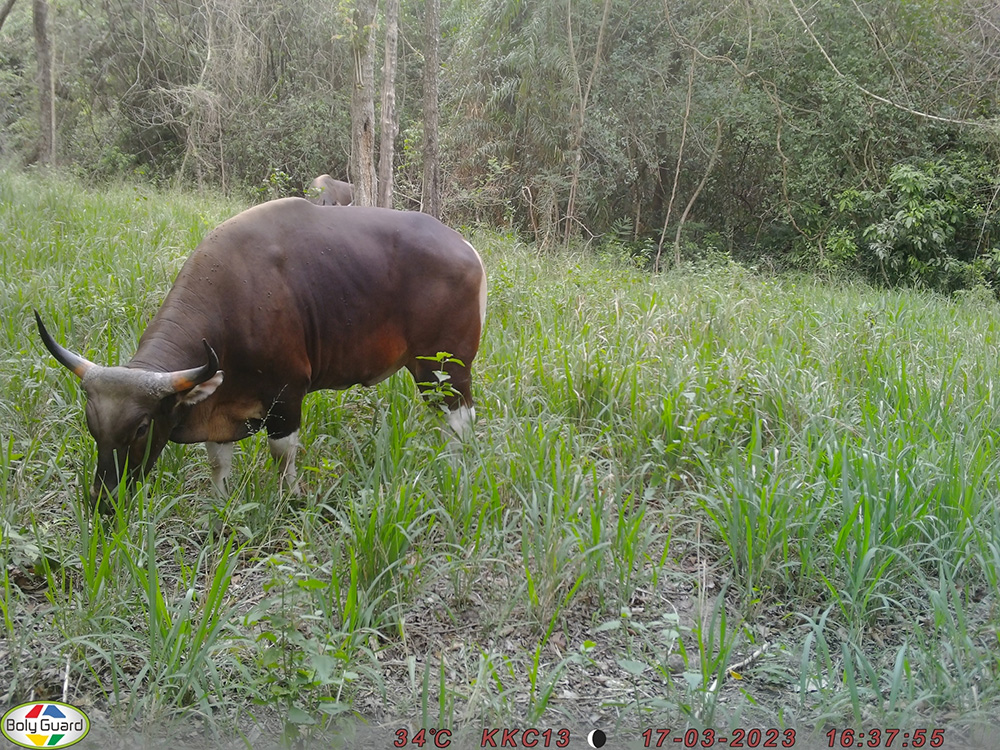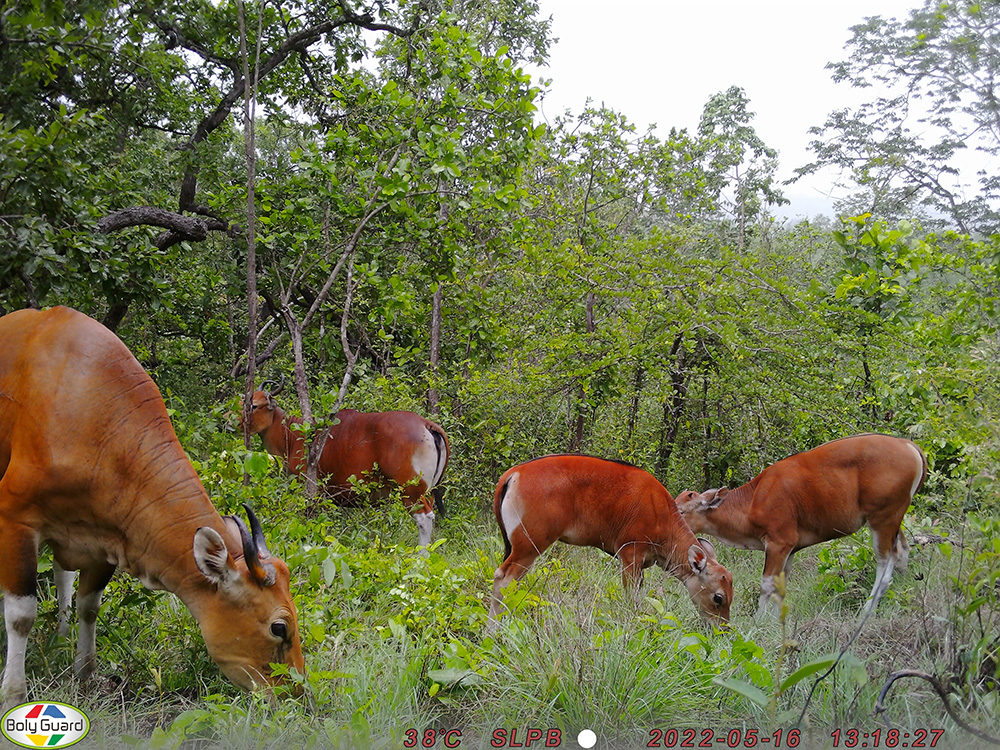การติดตามนิเวศวิทยาประชากรและการเติบโตของวัวแดง (Bos javanicus) ภายหลังการปล่อยคืนสู่ธรรมชาติในเขตรักษาพันธุ์สัตว์ป่าสลักพระ จังหวัดกาญจนบุรี และเขตรักษาพันธุ์สัตว์ป่าเขาเขียว-เขาชมภู่ จังหวัดชลบุรี
Monitoring of Population Ecology and Growth Rate of Banteng (Bos javanicus) after the Reintroduction in Salakphra Wildlife Sanctuary, Kanchanaburi Province and Khao Khieo - Khao Chompu Wildlife Sanctuary, Chonburi Province

Description
Installing camera traps to monitor the population and growth rate of red cows and compare areas where they were once inhabited before facing extinction. The population has subsequently been restored through the world's first systematic release, following the IUCN/SSC release manual (2013), and has evolved into a standard release model. Once photos of red cows and other wild animals in the area are obtained, they will be used to establish a crucial database for determining measures and policies for the conservation of natural resources and the environment in the region. This will also serve as a prototype model for other areas, ensuring consistency with economic development while promoting sustainable natural resource conservation efforts.
The primary objective is to study the population ecology and growth rate of red calves after their release into the wild. This involves monitoring the daily activities of red cows following their release back into nature, specifically in Salak Phra Wildlife Sanctuary and Khao Kheow - Khao Chomphu Wildlife Sanctuary. The study aims to provide guidelines for preparing areas before releasing red cows back into nature in other regions.
MU-SDGs Case Study Content
For the continuous progression of the red cow release initiative in both areas, it is imperative to systematically monitor the population ecology and growth rate post-establishment in the wild.
This is crucial to align with the management plan aimed at safeguarding species at risk of extinction in Thailand, as well as the 12th National Economic and Social Development Plan (2017–2021). This comprehensive plan embodies a development concept emphasizing "People are the center of development," urging active participation from the public, private, public, and educational sectors in addressing this critical issue.
The primary objective is to delve into the population ecology and growth rate of red calves subsequent to their release into the wild. This involves the continuous monitoring of the daily activities of red cows after their reintegration into nature, specifically within Salak Phra Wildlife Sanctuary and Khao Kheow - Khao Chomphu Wildlife Sanctuary. The study aims not only to fulfill the immediate objectives in these sanctuaries but also to provide comprehensive guidelines for preparing areas before the release of red cows into nature in other regions.
Operation
1. Install wildlife camera traps to cover the entire living area of red cows in Salak Phra Wildlife Sanctuary and Khao Kheow - Khao Chomphu Wildlife Sanctuary.
2. Classify the obtained images, noting the number of individuals, date, time, and season in which they were captured.
3. Analyze the distribution of spatial data to estimate opportunities for distribution in Salak Phra Wildlife Sanctuary and Khao Kheow - Khao Chomphu Wildlife Sanctuary, identifying relationships between various environmental factors and the presence of wild animals.
4. Analyze circadian activity patterns of red cows to study their activities throughout the day or during times of activity in the study area. This helps in understanding the behavior of red cows and studying the selection of areas for their daily activities.
5. Estimate the population and assess the population structure of red cattle.
6. Monitor activities throughout the day and analyze the statistical results to create a graphical representation of the activity patterns of red cows during each period.
7. Conduct statistical data analysis to identify differences in the red cow populations between Salak Phra Wildlife Sanctuary and Khao Kheow - Khao Chomphu.
Operation Results
In the second year at Salak Phra Wildlife Sanctuary,10 locations were identified where red cows were found. Data on the population structure of red cows, raised at the Khao Nam Phu Nature and Wildlife Education Center before being released into nature, indicated a total of 23 individuals with a male-to-female ratio of 12:11. Post-release data obtained from animal camera traps within Salak Phra Wildlife Sanctuary revealed a consistent male-to-female ratio of 12:11. The physical development of the 23 red cows raised at the Khao Nam Phu Nature and Wildlife Education Center before release increased with age, with males showing better physical development than females. This pattern was also observed in the red cows released back into the wild within Salak Phra Wildlife Sanctuary. The growth rate and body development of red calves showed sexual dimorphism between males and females. Male red calves exhibited varying morphological characteristics, especially after reaching 3 years of age, including features like horn rings, body size, skin color, and dewlap. Generally, male red cows are dark brown, larger in size, reaching a height of 160 centimeters and weighing approximately 600–800 kilograms. Female red cows undergo morphological changes after 3 years, with lighter weight, light brown or tamarind seed-colored skin, reaching a height of 140 centimeters, and weighing approximately 590–670 kilograms.
In the second year at Khao Kheow – Khao Chomphu Wildlife Sanctuary, 7 locations were identified where red cows were found. Data from camera traps capturing red cows that have ventured into the wild within Khao Kheow – Khao Chomphu Wildlife Sanctuary indicated a male-to-female ratio of 12:11. Similar to Salak Phra Wildlife Sanctuary, the physical development of red cows released into the wild within Khao Kheow – Khao Chomphu Wildlife Sanctuary also increased with age, with males exhibiting superior physical development compared to females. This finding aligns with the observations from red cows raised at the Khao Nam Phu Nature and Wildlife Education Center and released back into nature within the Salak Phra Wildlife Sanctuary.
Utilization
Government sector: Department of National Parks, Wildlife and Plant Conservation
Published work
Chaiyarat R, Ingudomnukul P, Yimphrai N, Nakbun S, Youngpoy N. The preferred habitat of reintroduced banteng (Bos javanicus) at the core and the edge of Salakphra Wildlife Sanctuary, Thailand. Animals, 2023, 13, 2293. https://doi.org/10.3390/ani13142293. ISI Impact Factor = 3.231, SJR Quartile = Q1
Chaiyarat R, Sriphonkrang N, Khamsirinan P, Nakbun S, Youngpoy N. Age structure, development and population viability of banteng (Bos javanicus) in captive breeding for ex-situ conservation and reintroduction. Animals, 2023, 13(2), 198. https://doi.org/10.3390/ani13020198. ISI Impact Factor = 3.231, SJR Quartile = Q1
คDifferences or uniqueness that is different from other projects
This involves a comparison of the area selection for red cows that have been released into the natural forest and those that have been systematically released—a pioneering initiative that has not been undertaken previously.
Impacts at the community, country, and global levels
Raise awareness within the community about the significance of conserving red cows and other natural resources in the area, aiming to foster environmental sustainability.
National Level: Acquire information on the preparation for releasing red cows back into the wild and enhance the management of the red cow's habitat. This effort is geared towards supporting the population of red cows to be released in the future.
Global Level: Obtain information on the preparation for releasing red cows back into the wild and improve the management of the red cow's habitat, aiming to support the future population of released red cows. This initiative is groundbreaking globally and can serve as a model for advancing conservation efforts in other regions around the world.
Key Message
Releasing wild animals, which are the most crucial prey for tigers, back into nature is a method to restore damaged and degraded terrestrial life and ecosystems, allowing them to function efficiently and sustainably once again.
สอดคล้องกับยุทธศาสตร์มหาวิทยาลัย
Partners/Stakeholders
Department of National Parks, Wildlife and Plant Conservation
Royal Forest Department







